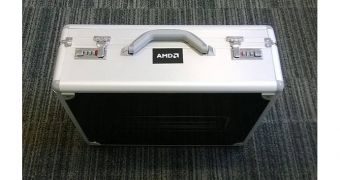Today is April 1, which means that every bit of news released could be a hoax. Thus, the latest information that emerged about the upcoming dual-GPU graphics card from Advanced Micro Devices might not be true.
Then again, the report does come with a photo, so it might be genuine after all. Unless AMD itself is trolling the world, which is less of a stretch than you might think.
Anyway, hoax or no, a rumor is a rumor, and when it comes to highly anticipated (albeit unlikely to sell all that much) products, it's better to be on the safe side.
First off, the Radeon R9 295 X2 graphics adapter, featuring two Hawaii XT chips, will be housed in a metal briefcase with two combination locks.
Secondly, the board will have a hybrid air+liquid cooling module, albeit not an all-in-one type. You'll need a water cooling system inside your desktop for the liquid cooling support to be of any use.
Thirdly, AMD will adopt the same, humongous and borderline absurd price of $3,000 / €3,000. This is what makes us think this could be a hoax, since it's doubtful that the Sunnyvale, California-based company would just mirror NVIDIA that way.
Granted, it might just be hope at work here, hope that three thousand dollars / euro hasn't truly become the standard price of dual-GPU graphics boards.
After all, it's a pretty huge leap from the $1,000 / €1,000 (or that and a half) of previous-generation cards.
Furthermore, AMD does not have the excuse of ludicrous VRAM amount to justify such a price, because the Radeon R9 295 X2 will only have 8 GB of GDDR5 (4 GB per Hawaii XT GPU).
NVIDIA's GeForce GTX Titan Z has 12 GB, even though its GPUs have a smaller memory bus than AMD's chips (2 x 384 bits versus 2 x 512 bits).
The report from VideoCardz didn't say anything else, other than confirming the rest of the technical aspects that were mentioned or implied in previous reports: five display outputs (five mini DisplayPort connectors, dual-link DVI only digitally supported) and a TDP of 500W (250W per GPU).
Ironically enough, if the price really does turn out to be of $3,000 / €3,000, the number of buyers probably won't drop all that much compared to previous generations. After all, the only people who get such hardware are the ones that afford overpowered and expensive memory, CPU, motherboards, cooling, etc. In other words, those who have more money than they know what to do with.

 14 DAY TRIAL //
14 DAY TRIAL //